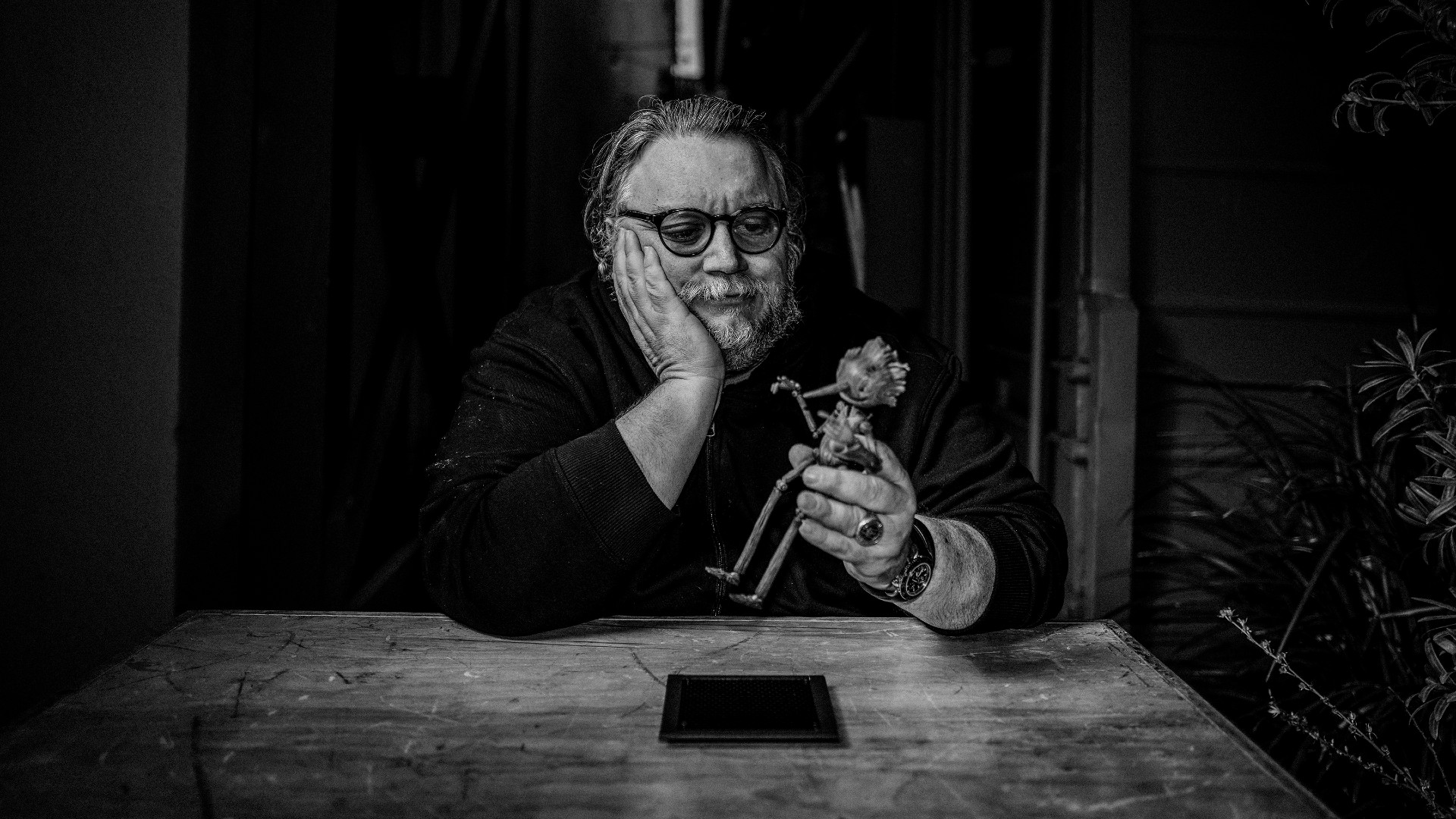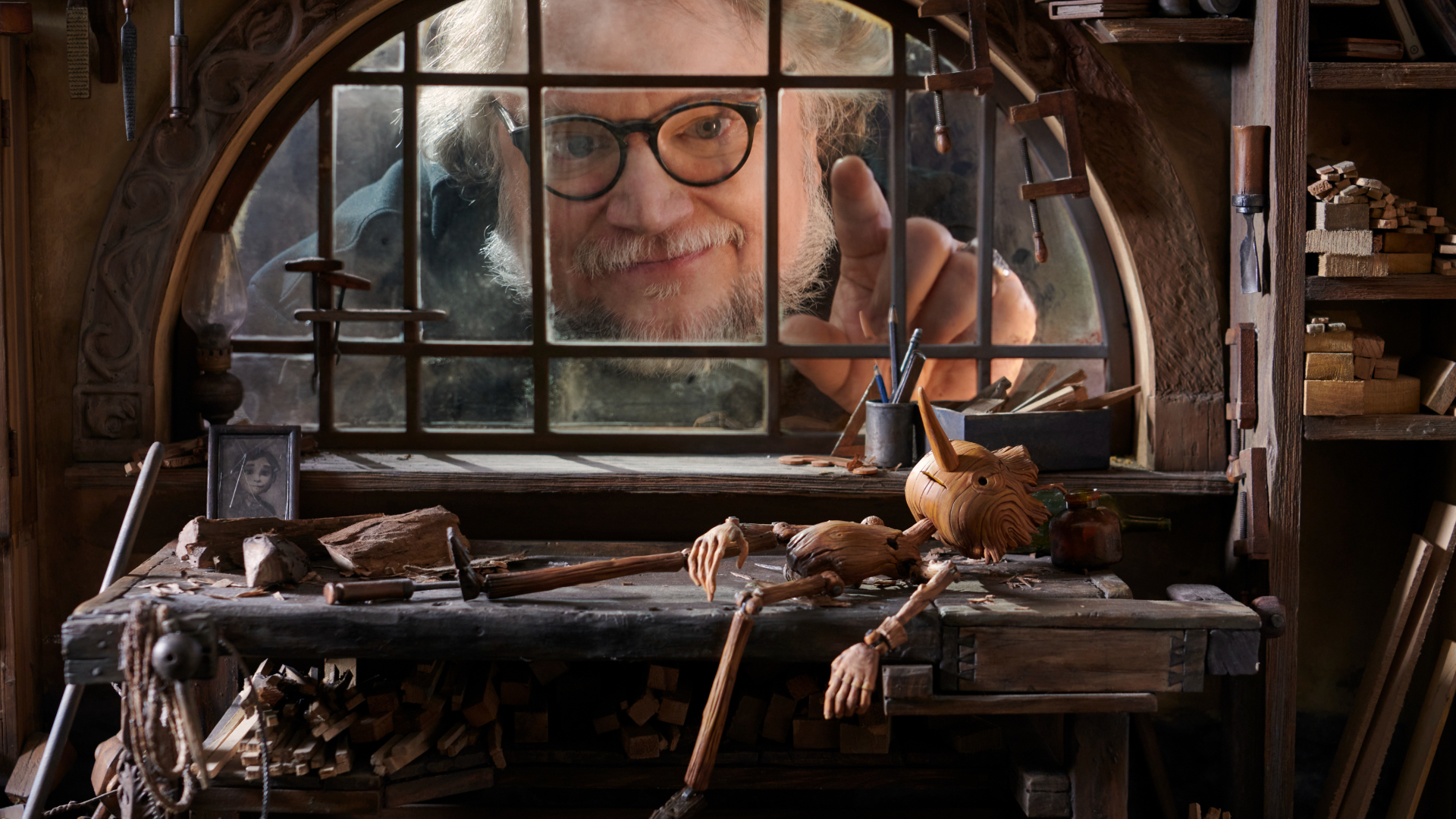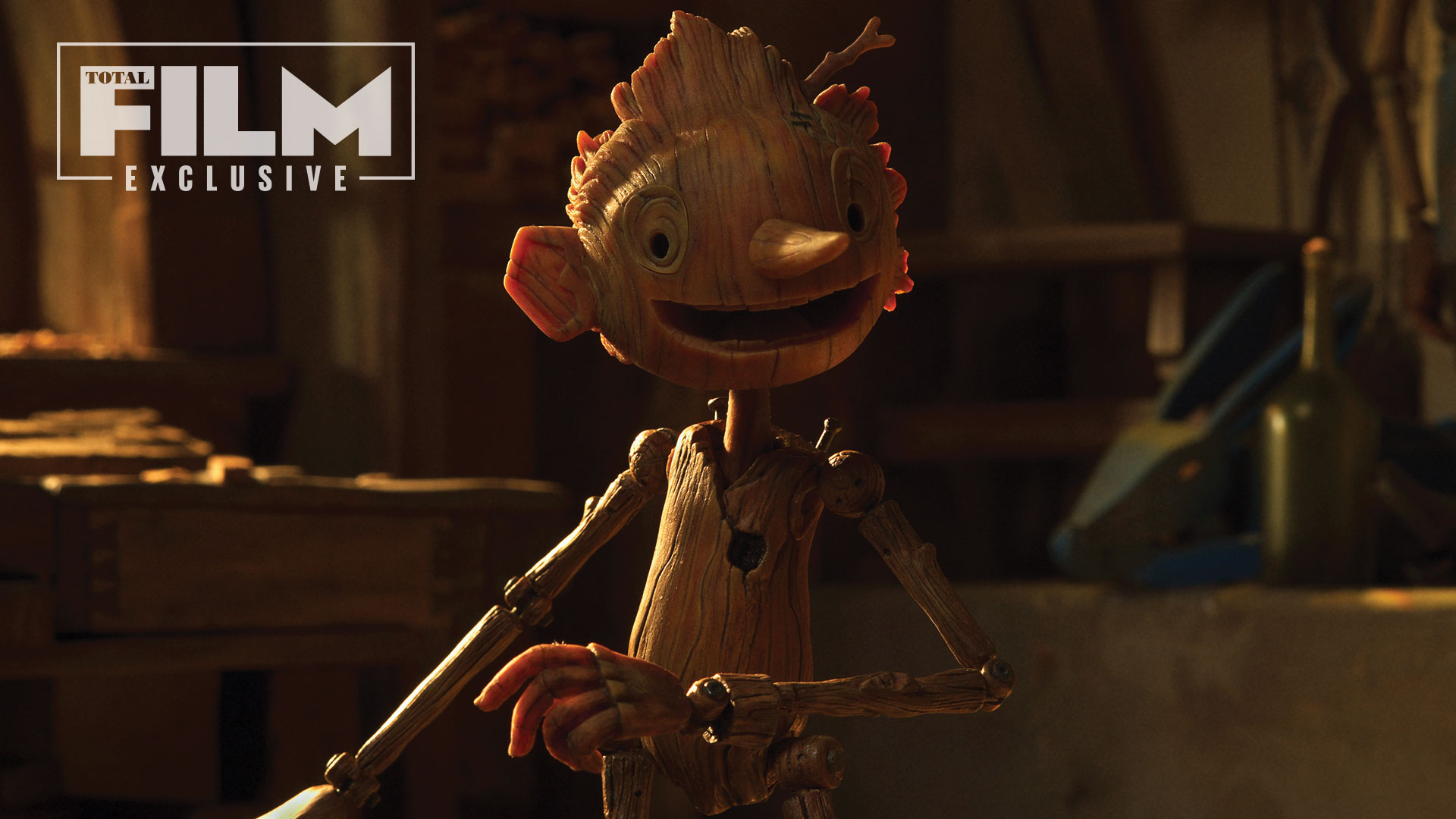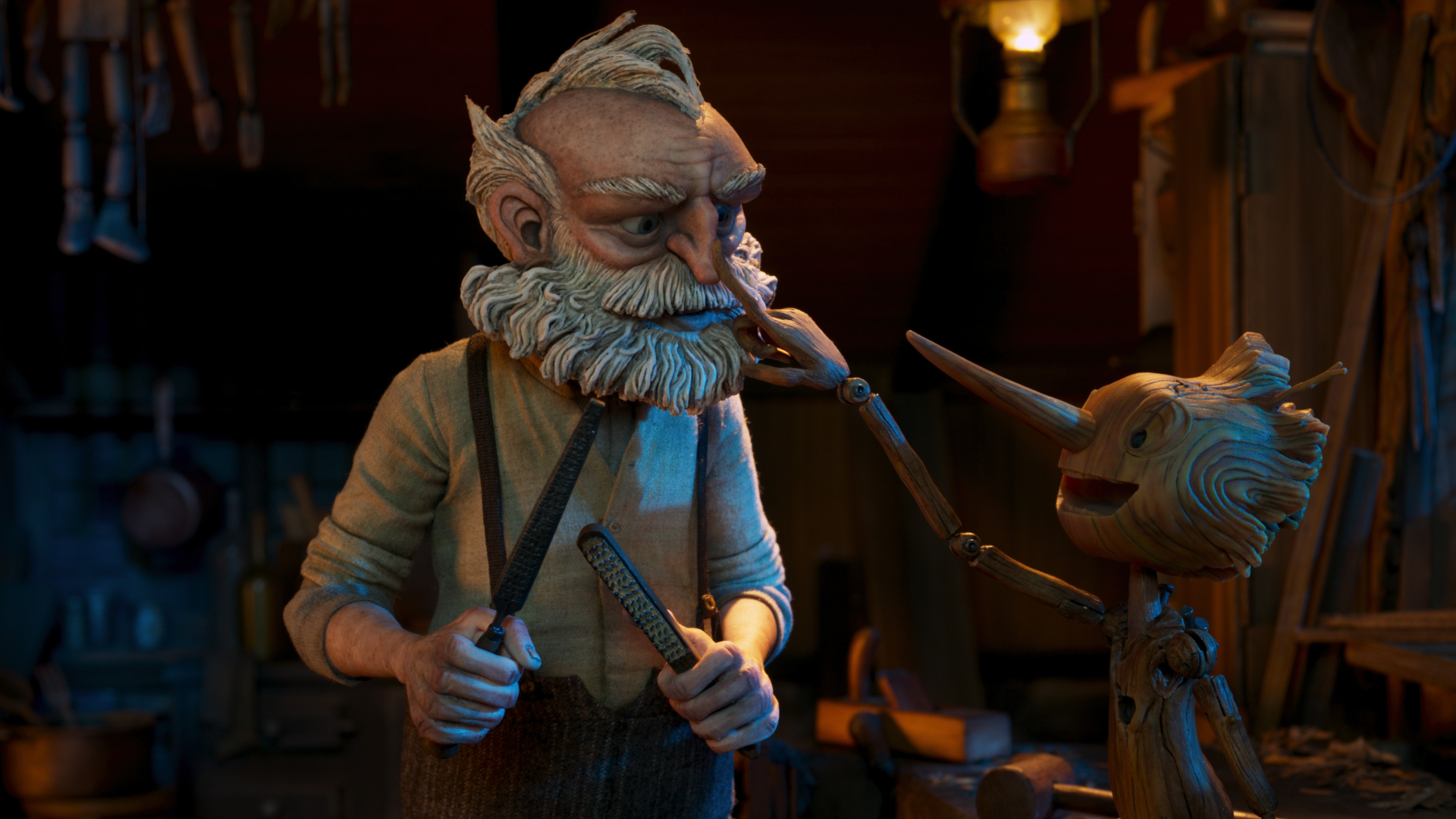Guillermo del Toro talks Pinocchio: "To animate is to give soul"
The director behind The Shape of Water, Pan's Labyrinth, and Hellboy talks to Total Film about his version of Pinocchio and why this adaptation isn't necessarily for kids

Pinocchio may have been adapted before, but never quite like this. Guillermo del Toro and his co-director Mark Gustafson have created a wonderfully realized wooden world for their puppet to playfully walk through – one that's a million miles away from Disney's recent attempt at adapting Pinocchio.
The first ten minutes of del Toro's creation emphasize just how wide the chasm is between these two takes on Carlo Collodi's story. Geppetto (voiced by David Bradley) appears to live happily with his real son when disaster strikes: a rogue bomb falls from an airplane above and kills Geppetto's boy. The master woodsman turns to drink, sinking into alcoholism. It's hard-hitting stuff.
No wonder, then, that del Toto warns Total Film that his version of Pinocchio is "not made for children". In our conversation with the filmmaker and Gustafson (making his directorial debut after working as an animator for many years), the pair touched on why two major Pinocchio movies came in one year, how Pinocchio and Frankenstein are related, and the astonishing animation process that led to the movie. Here's our Q&A, edited for length and clarity.
Total Film: I was really struck by how different this version of Pinocchio is; how he's portrayed as being disobedient rather than obedient, and how his creation is framed like Frankenstein's monster. What went into those decisions?
Del Tor: Early, early on, in my childhood, these two myths complemented each other, Frankenstein and Pinocchio. But when we started this journey, we said well, 'Well, what can we shake, in terms of story, and what haven't we seen before?' The characters that change are the characters who normally teach Pinocchio in the fable. The cricket changes a lot during the movie, Geppetto completely transforms. And Pinocchio remains in a steady course of disobedience, all the way to the end. He learns that the only lie that is dangerous is that he should never lie to himself, he stays true to himself. So these ideas fuse. And we went back to [author Carlo] Collodi [who originally created Pinocchio] for certain gestures that haven't been put in a Pinocchio film – like the fact that Pinnochio dies several times and the cricket gets crushed constantly; like the fact that Pinocchio, in the beginning, is really unruly, and is not a domesticated, pleasant, quiet, angelic. He's an almost feral elemental.
That sounds tricky to have a main character who doesn't go through the arc, but the other characters around him go through arcs. Was that hard to balance?
Del Toro: Well, in the writing of the piece, what we wanted very much was to give Pinocchio a learning curve that was emotionally moving. When he says, who was Carl? They say, is he a child he lost? How could he lose a whole child? There's no, he's dead? Is that a bad thing? And he learns about death. And he learns about life, and how sacred and brief human life is. And the course of the journey is incredibly moving because of that. He's not learning to behave, he is not learning morality. He's learning ethics and spirituality, which is a lot deeper.
Bringing all the latest movie news, features, and reviews to your inbox
Mark Gustafson: It is. We're sort of playing with the audience's expectations in a way, you know, you go in and you really think about this character as learning to be a good boy. And when you flip that, it becomes something very different the world learns from him ultimately. And that's a very different story.

The story is a part of the cultural zeitgeist, and there was another Pinocchio film out this year. What about this story has made it feel so relevant right now, so that there are the two version at once?
Del Toro: First of all, there are over 60 Pinocchios on film, by an informal account. He's maybe one of 12 characters in the history of literature that people know even if they haven't read the book. Frankenstein, Pinocchio, Dracula, Sherlock Holmes, Tarzan, Count of Monte Cristo. People think they know the story, but they really don't. So it allows you to use it as a metaphor for science going array, or why you can put Pinnochio in the future, you can make him a robot, you can put him in the past, you can make him a political figure that lies, you can make him a family member. It's incredibly malleable. For Pinocchio, for now, I think it's because we live in a time where the grasp of truths and lies is incredibly tenuous, and the fact that we are living in a time where we are seeing obedience permeate basically every arena of our public and private life. Ideology is taking the place of ideas in every arena. We're making 'the other' a malignant figure. This Pinocchio doesn't land in the town and everybody likes him. This Pinocchio lands in the town and everybody's scared of him. They think, 'How are we going to control him? He's an unruly character!
Gustafson: It's a story about creation. For us, as artists, what could be more important than a story about creation? And it's a story about how the world views your creation. When you create something, as much as you think about what you're making, there are going to be different ramifications – there are going to be people who are going to interpret it differently, and your creation might run around and cause trouble. Your ideas are going to cause trouble.
Del Toro: Which is good!
Gustafson: Which is fantastic. And that's what we're saying. At first, this may be shocking. And you're like, 'Oh, I need to adjust to this.' But why would you want to put something out into the world that didn't challenge people at all? You want people to go, 'I didn't see that coming!'
Even at the beginning of this film, we haven't seen a Pinocchio story where we see the real Geppetto's son die after getting to know him. It's heartbreaking.
Gustafson: We wanted Pinocchio to be real. We wanted you to care about him. And one way to do that is to understand the grief that he was born from. And Geppetto is a much more important character in our film than in other versions,
Del Toro: He's a character with a lot of flinty areas and a lot of edges. Geppetto is ill-tempered, he drinks, and he's a snappy character to himself. He likes obedience. And he's a very domesticated character at the beginning of the film, and he learns to embrace more of the wildness of Pinocchio. The earliest idea was to make Pinocchio born out of grief. To me, Frankenstein and Pinocchio are very related. The biggest difference is that Victor births the creature out of arrogance. But Pinocchio is birthed out of grief. That was one of the seeds. No pun intended.

Guillermo, you've said this is one of the most personal stories you have put on screen as it deals with fathers and sons. Can you expand on that?
Del Toro: It's one of them. It's of a piece with The Devil's Backbone and Pan's Labyrinth for me, but also Shape of Water and Nightmare Alley. What people see as filmography, you see as biography. Once we have everybody involved, the great gift of a film like this is that it becomes everybody's personal film. Mark's, the animators. It's a very unique enterprise. I'll tell you, it's the only movie I've ever done in which people started as friends and ended as family. We have an impeccable record of commitment on this movie, everybody was committed 100%, 100% of the time, and we ended up having people love the movie as much as Mark or I or anybody.
Gustafson: And we shot for about 1000 days. So you can imagine the pressure that puts on. So you want to be working with people that share your same vision and enthusiasm for it.
Del Toro: But the story the basics of the story never changed. But it became deeper and deeper and deeper. The cast brought depth, the animation brought depth, it was very, very moving to see it become more and more effective emotionally.
Was there ever a worry that you were creating something that wasn't necessarily suitable for kids today? Because many stories that are told are almost bubble-wrapped now, but that's not the tradition of fables, like Little Red Riding.
Del Toro: The scariest things I saw as a kid were animated. And it's not only the Disney movies that were scary but also the Japanese animations that have a wistful melancholic sense of danger and loss. When I pitched this story, I said it is of a piece with The Devil's Backbone and Pan's Labyrinth. I said it is not made for children. But children can watch it if their parents speak to them. I would not fool myself on say Pan's Labyrinth is a kid's movie, but this one can be watched by kids. It's not pasteurized, it's not homogenized, and it's not immune to dialogue in the family.

To touch on the animation, you treated the animators as actors and allowed them to have "failed acts" where the characters do the wrong thing. Mark, you've worked on the animation side of likes of Fantastic Mr. Fox, but was this the most free-flowing process you've seen?
Gustafson: The basic process is largely the same in terms of starting with the script and recording the voices. And at the same time, you're generally working on storyboards, and then you cut an animatic, and then you go into shooting. But on this, I think our voice talent really informed the animation in an interesting way. Ewan McGregor came on and just breathed life into this cricket. We saw it immediately, we're like, 'Oh, that's, that's Sebastian J. Cricket.' Because there was so much warmth and he could be arrogant, but you still really liked this cricket. [Blue Fairy voice] Tilda [Swinton], she's just ethereal, and what she brought to that character really made it resonate in a very interesting way. And then we had our Pinocchio. We found Greg [Mann], this kid who was 10 years old, and he was remarkable – not very experienced, but there was something so genuine and sweet and real about him.
Del Toro: And unruly.
Gustafson: And unruly. He could absolutely get into it. In fact, I think he reveled in the stuff where we asked him to be a little bit more broad and disobedient.
Del Toro: To your question, the vehicle, the technical parts of a movie like this are the same, but where you take that vehicle is very different. We staged the camera a lot more actively, like live-action. We gave the camera and the actors a reason to move. We went for micro-expressions, we went for the "failed acts", and we shied away from sanitized pantomime completely. There are no cool poses, no hip attitudes, there was only humanity. The "failed act", which sounds really easy, but when you don't take a direct route between an action and the result, the animation multiplies the man-hours and makes it a lot more elaborate. That's why we shot for 1000 days. We were looking for humanity and we were looking for the craft and the humans behind this as opposed to making it look sleek and remote and perfect. I want to make it feel handmade. Although the process steps are the same, the direction in which we took the movie was completely adventurous.
Gustafson: You find humanity around the edges, it is in those failed gestures, it's in the things that you might not think are absolutely in the moment, but they make that character alive. It's in the eyes. We put a special emphasis on reactions, like watching someone listening, because when, as an audience or when you're watching a character listening, and watching him processing information, not talking, but thinking, that's what makes a character alive.
Del Toro: When we were animating, especially on the first third of the process, we would look at where we're coming from, where we're going, and look at the scene and see what we think the character is feeling. To animate is to give a soul, we had to understand what the character is feeling. I don't want to just see the character move. I want to understand what they're feeling physically and emotionally. Are they in pain? Do they have an itch? Are they sweaty? Are they tired? Are they happy? Are they sad? Are they receiving news? Are they rejecting news? That's a very different way of directing animation normally.
Guillermo del Toro's Pinocchio is on Netflix from December 9. For more, check out the best Netflix movies streaming right now.

Jack Shepherd is the former Senior Entertainment Editor of GamesRadar. Jack used to work at The Independent as a general culture writer before specializing in TV and film for the likes of GR+, Total Film, SFX, and others. You can now find Jack working as a freelance journalist and editor.


